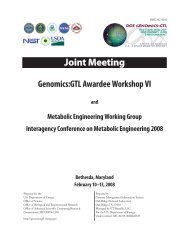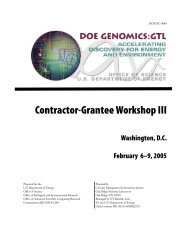Joint Meeting - Genomics - U.S. Department of Energy
Joint Meeting - Genomics - U.S. Department of Energy
Joint Meeting - Genomics - U.S. Department of Energy
You also want an ePaper? Increase the reach of your titles
YUMPU automatically turns print PDFs into web optimized ePapers that Google loves.
Milestone 1<br />
22<br />
High-Throughput Production and Analyses <strong>of</strong> Purified Proteins<br />
F. William Studier 1 * (studier@bnl.gov), John C. Sutherland 1,2 , Lisa M. Miller 1 , Michael Appel 1 , and<br />
Lin Yang 1<br />
1 Brookhaven National Laboratory, Upton, NY and 2 East Carolina University, Greenville, NC<br />
This work is aimed at improving the efficiency <strong>of</strong> high-throughput protein production from cloned<br />
coding sequences and developing a capacity for high-throughput biophysical characterization <strong>of</strong> the<br />
proteins obtained. Proteins <strong>of</strong> Ralstonia metallidurans, a bacterium that tolerates high concentrations<br />
<strong>of</strong> heavy metals and has potential for bioremediation, are being produced to test and improve<br />
the efficiency <strong>of</strong> protein production in the T7 expression system in Escherichia coli. Auto-induction<br />
greatly simplifies protein production, as cultures can simply be inoculated and grown to saturation<br />
without the need to monitor culture growth and add inducer at the proper time. New vectors allow<br />
maintenance and expression <strong>of</strong> coding sequence for proteins that are highly toxic to the host. Vectors<br />
having a range <strong>of</strong> expression levels have also been made and will be tested for whether tuning the<br />
expression level can improve the production <strong>of</strong> soluble, well folded proteins.<br />
Proteins produced from clones are <strong>of</strong>ten improperly folded or insoluble. Many such proteins can be<br />
solubilized and properly folded, whereas others appear soluble but remain aggregated or improperly<br />
folded. As high-throughput production <strong>of</strong> purified proteins becomes implemented in GTL projects<br />
and facilities, reliable analyses <strong>of</strong> the state <strong>of</strong> purified proteins will become increasingly important for<br />
quality assurance and to contribute functional information. Beam lines at the National Synchrotron<br />
Light Source analyze proteins by small-angle X-ray scattering (SAXS) to determine size and shape,<br />
X-ray fluorescence microprobe to identify bound metals, and Fourier transform infrared (FTIR) and<br />
UV circular dichroism (CD) spectroscopy to assess secondary structure and possible intermolecular<br />
orientation. A liquid-handling robot for automated loading <strong>of</strong> samples from 96-well plates for analysis<br />
at each <strong>of</strong> these stations has been built and implemented with purified proteins. These data will be<br />
used as a training set for multivariate analysis <strong>of</strong> new proteins, to determine whether they are folded<br />
properly, obtain information on dynamics and stability, and provide an approximate structure classification.<br />
Work has also begun on an automated data reduction and analysis pipeline to process the<br />
biophysical information obtained for each protein, and an associated database with a web interface.<br />
When fully functional, the system will be capable <strong>of</strong> high-throughput analyses <strong>of</strong> size, shape, secondary<br />
structure and metal content <strong>of</strong> purified proteins.<br />
This project is supported by the Office <strong>of</strong> Biological and Environmental Research <strong>of</strong> the <strong>Department</strong> <strong>of</strong> <strong>Energy</strong>.<br />
Work on auto-induction and vector development also receives support from the Protein Structure Initiative <strong>of</strong> the<br />
National Institute <strong>of</strong> General Medical Sciences <strong>of</strong> NIH, as part <strong>of</strong> the New York Structural <strong>Genomics</strong> Research<br />
Consortium.<br />
30 * Presenting author





